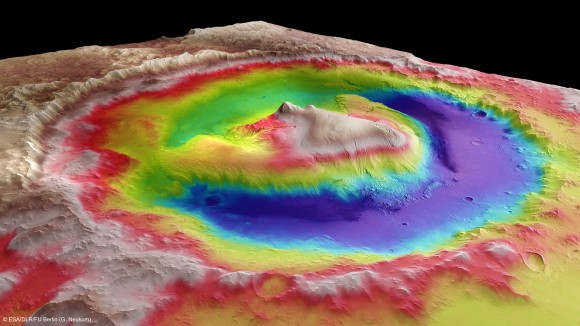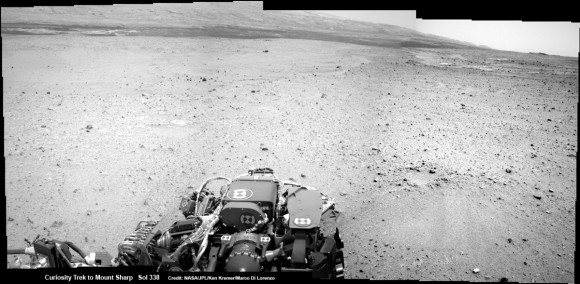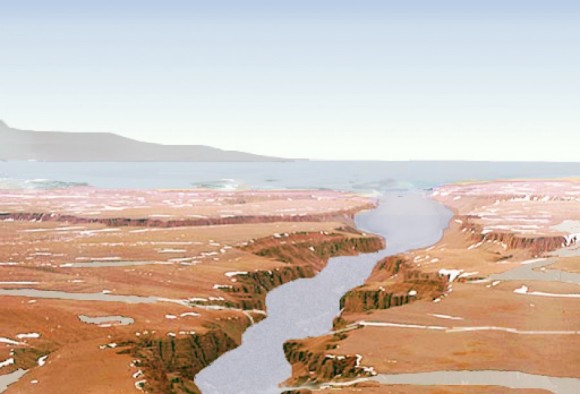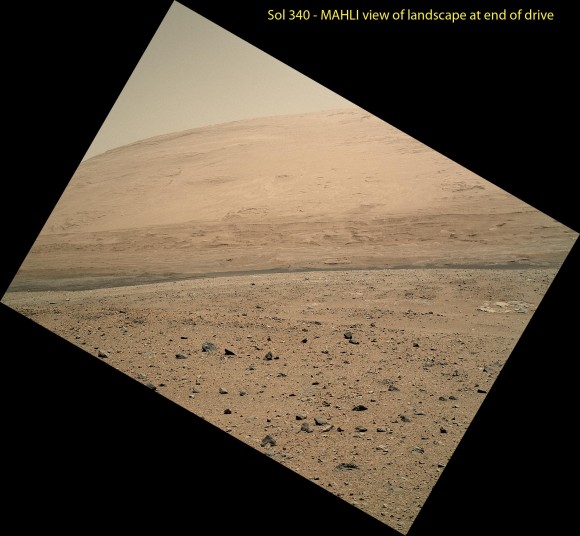
Moderators: Elvis, DrVolin, Jeff
 .
.




http://www.jpl.nasa.gov/spaceimages/details.php?id=PIA17356
Annular Eclipse of the Sun by Phobos, as Seen by Curiosity
This set of three images shows views three seconds apart as the larger of Mars' two moons, Phobos, passed directly in front of the sun as seen by NASA's Mars rover Curiosity. Curiosity photographed this annular, or ring, eclipse with the telephoto-lens camera of the rover's Mast Camera pair (right Mastcam) on Aug. 17, 2013, the 369th Martian day, or sol, of Curiosity's work on Mars.
Curiosity paused during its drive that sol for a set of observations that the camera team carefully calculated to record this celestial event. The rover's observations of Phobos help researchers to make measurements of the moon's orbit even more precise. Because this eclipse occurred near mid-day at Curiosity's location on Mars, Phobos was nearly overhead, closer to the rover than it would have been earlier in the morning or later in the afternoon. This timing made Phobos' silhouette larger against the sun -- as close to a total eclipse of the sun as is possible from Mars.

http://rt.com/news/curiosity-nasa-mars-water-416/
NASA rover Curiosity finds water in Mars soil - report
Published time: September 26, 2013 21:06
The rover Curiosity has discovered water in fine-grained soil on the surface of Mars, NASA confirmed Thursday in a series of papers published in the journal Science.
Each cubic foot of Martian soil contains about two pints of liquid water, though the molecules are bound to other minerals in the soil.
Curiosity first landed on Mars in August 2012 on Gale Crater, near the equator of the planet. Its aim was to circle and scale Mount Sharp, in the middle of the crater, a five-kilometer-tall mountain that will help NASA understand the history of Mars.
NASA scientists released the first detailed, peer-reviewed results of Curiosity’s experiments done during its first four months on Mars in a series of five papers published in Science.
"We tend to think of Mars as this dry place -- to find water fairly easy to get out of the soil at the surface was exciting to me," said Laurie Leshin, dean of science at Rensselaer Polytechnic Institute and lead author on the Science paper that verified existence of water in the surface soil.
"If you took about a cubic foot of the dirt and heated it up, you'd get a couple of pints of water out of that -- a couple of water bottles' worth that you would take to the gym,” she said, according to the Guardian.
Curiosity found about 2 percent of the soil, by weight, was water by scooping dirt samples under its wheels and depositing them into an oven in a centralized compartment called Sample Analysis at Mars.
"We heat [the soil] up to 835C and drive off all the volatiles and measure them," said Leshin. "We have a very sensitive way to sniff those and we can detect the water and other things that are released."
The rover also found sulphur dioxide, carbon dioxide and oxygen as soil and minerals collected decomposed with increased temperature.
A main aim of Curiosity’s missions is to find out whether Mars was ever hospitable to life. Scientists believe water was once abundant on the surface of the planet, but it has since almost completely disappeared.
Nasa's Curiosity rover finds water in Martian soil
Dirt sample reveals two pints of liquid water per cubic feet, not freely accessible but bound to other minerals in the soil
Alok Jha, science correspondent
The Guardian, Thursday 26 September 2013 14.14 EDT
Water has been discovered in the fine-grained soil on the surface of Mars, which could be a useful resource for future human missions to the red planet, according to measurements made by Nasa's Curiosity rover.
Each cubic foot of Martian soil contains around two pints of liquid water, though the molecules are not freely accessible, but rather bound to other minerals in the soil.
The Curiosity rover has been on Mars since August 2012, landing in an area near the equator of the planet known as Gale Crater. Its target is to circle and climb Mount Sharp, which lies at the centre of the crater, a five-kilometre-high mountain of layered rock that will help scientists unravel the history of the planet.
On Thursday Nasa scientists published a series of five papers in the journal Science, which detail the experiments carried out by the various scientific instruments aboard Curiosity in its first four months on the martian surface. Though highlights from the year-long mission have been released at conferences and Nasa press conferences, these are the first set of formal, peer-reviewed results from the Curiosity mission.
"We tend to think of Mars as this dry place – to find water fairly easy to get out of the soil at the surface was exciting to me," said Laurie Leshin, dean of science at Rensselaer Polytechnic Institute and lead author on the Science paper which confirmed the existence of water in the soil. "If you took about a cubic foot of the dirt and heated it up, you'd get a couple of pints of water out of that – a couple of water bottles' worth that you would take to the gym."
About 2% of the soil, by weight, was water. Curiosity made the measurement by scooping up a sample of the Martian dirt under its wheels, sieving it and dropping tiny samples into an oven in its belly, an instrument called Sample Analysis at Mars. "We heat [the soil] up to 835C and drive off all the volatiles and measure them," said Leshin. "We have a very sensitive way to sniff those and we can detect the water and other things that are released."
Aside from water, the heated soil released sulphur dioxide, carbon dioxide and oxygen as the various minerals within it were decomposed as they warmed up.
One of Curiosity's main missions is to look for signs of habitability on Mars, places where life might once have existed. "The rocks and minerals are a record of the processes that have occurred and [Curiosity is] trying to figure out those environments that were around and to see if they were habitable," said Peter Grindrod, a planetary scientist at University College London who was not involved in the analyses of Curiosity data.
Flowing water is once thought to have been abundant on the surface of Mars, but it has now all but disappeared. The only direct sources of water found so far have been as ice at the poles of the planet.
The other papers included x-ray diffraction images of the soil in order to work out the crystalline structure of the minerals on the Martian surface and analysis of a volcanic rock called "Jake_M", which is named after a Nasa engineer. The analysis showed that the rock was similar to a type on Earth known as a mugearite, which is typically found on ocean islands and in rift zones.
Grindrod said that the latest results published by the Nasa team were just the start of the scientific insights that would come from Mars in the next few years. "It's the first flexing of Curiosity's analytical muscles," he said. "Curiosity spent a long time checking out the engineering, instruments and procedures it was going to use – these papers cover just that engineering period. The targets here weren't chosen because of their science goals as such but as good targets to test out the instruments."
Leshin said that, as well as the excitement of exploring a new world for the first time, the increasingly detailed analysis of the Martian surface would be critical information for planning human missions. As well as the water discovery, analysis of the soil has also shown, for example, the presence of a type of chemical called a perchlorate, which is can be toxic to people. "It's only there at a 0.5% level in the soil but it impedes thyroid function," she said. "If humans are there and are coming into contact with fine-grained dust, we have to think about how we live with that hazard. To me it's a good connection between the science we do and the future human exploration of Mars."
She added: "I do think it's inevitable that we'll send people there and so let's do its as smartly as we can. Let's get as smart as we can before we go."

http://www.syracuse.com/news/index.ssf/2014/01/mars_rock_or_martian_mushroom_man_sues_nasa_to_make_it_take_closer_look_at_mystery_object.html
Mars rock or Martian mushroom? Man sues NASA to make it take closer look at mystery object
on January 30, 2014 at 4:49 PM
The object nicknamed "Jelly Donut" appears in the photo at right shot on the surface of Mars by the Opportunity rover, but not in the one the rover shot of the same ground 12 Mars days earlier. ( Mars Exploration Rover Mission | Cornell | JPL | NASA)
What NASA scientists say is an interesting Martian rock is actually evidence of Martian life, a California man says, and he's asking a court to order NASA to thoroughly examine the object.
Opportunity, the NASA robotic rover that's been exploring the surface of Mars for a decade, recently photographed the donut-shaped object at the Murray Ridge section of rim of Endeavour Crater.
The odd thing was, it wasn't there when Opportunity photographed virtually the same piece of ground 12 Mars days earlier, NASA Mars Exploration Rover lead scientist Steve Squyres told a rover anniversary celebration on Jan. 16, Discovery.com said.
"The leading explanation is somewhat tame -- the rock was recently scattered by one of the rover's tires," according to an explanation on NASA's website.
NASA dubbed the rock "Pinnacle Island," but its coloration -- a red center surrounded by a light area -- conjured up the nickname "Jelly Donut." A chemical analysis shows it contains more manganese than any other Martian rock examined before, NASA said.
It looks like more than a rock to Dr. Rhawn Joseph, however. Joseph, who describes himself as an astrobiologist in court papers, filed a petition for a writ of mandamus Monday in federal court in San Francisco to make NASA and its chief administrator, Charles Bolden, "closely photograph and thoroughly scientiï¬Âcally examine and investigate a putative biological organism" discovered by Opportunity.
Joseph suggests that what NASA calls a rock is actually a "mushroom-like fungus" that arose from spores, the ABA Journal reported. The court papers added:
"Any intelligent adult, adolescent, child, chimpanzee, monkey, dog, or rodent with even a modicum of curiosity, would approach, investigate and closely examine a bowl-shaped structure which appears just a few feet in front of them when 12 days earlier they hadn't noticed it."
Writing in Cosmology, Joseph said the object has a structure like Apothecia, a composite of fungus and cyanobacteria.
According to the New York Daily News, Joseph wants the rover to take 100 high resolution pictures from all sides of the object, close-up, in focus and under appropriate lightning conditions. He's also seeking two dozen microscopic photos of the object. And he wants NASA to give him copies.
NASA continues to analyze the object, NASA spokesman Allard Beutel told The Huffington Post, adding:
"Finding evidence of life on worlds other than Earth is obviously an important goal for NASA . . . But it has to be definitive evidence."
http://www.jpl.nasa.gov/spaceimages/details.php?id=PIA17932
A Spectacular New Martian Impact Crater
A dramatic, fresh impact crater dominates this image taken by the High Resolution Imaging Science Experiment (HiRISE) camera on NASA's Mars Reconnaissance Orbiter on Nov. 19, 2013. Researchers used HiRISE to examine this site because the orbiter's Context Camera had revealed a change in appearance here between observations in July 2010 and May 2012, bracketing the formation of the crater between those observations.
The crater spans approximately 100 feet (30 meters) in diameter and is surrounded by a large, rayed blast zone. Because the terrain where the crater formed is dusty, the fresh crater appears blue in the enhanced color of the image, due to removal of the reddish dust in that area. Debris tossed outward during the formation of the crater is called ejecta. In examining ejecta's distribution, scientists can learn more about the impact event. The explosion that excavated this crater threw ejecta as far as 9.3 miles (15 kilometers).
Users browsing this forum: No registered users and 45 guests